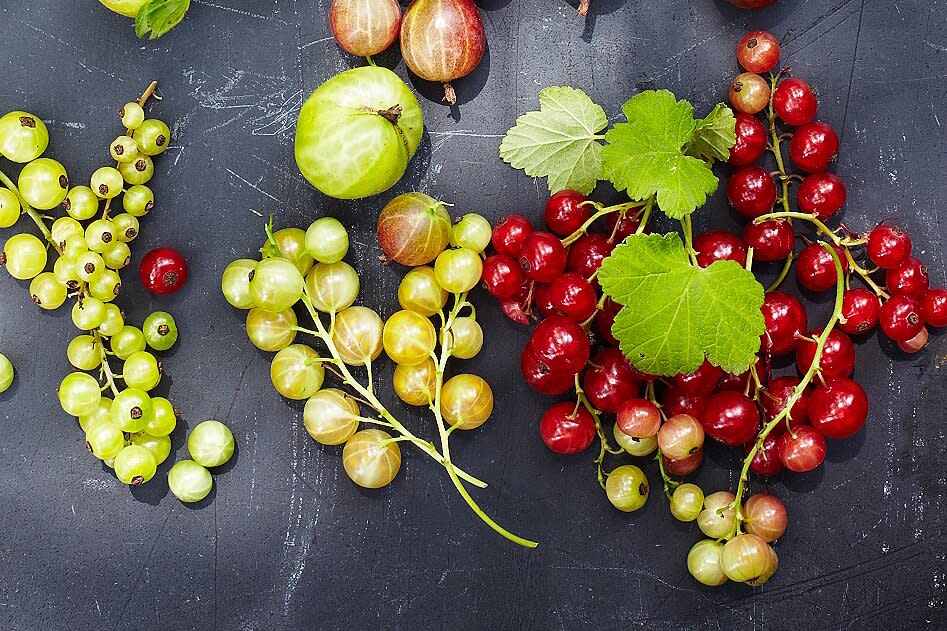Black, Red, and White Currants Are the Fresh, Dainty Berries You Should Seek Out Right Now
The jewel-like fresh berries that ripen on shrubs in midsummer and arrive in glistening waves of red, white, and black (if you are lucky) at farmers' markets for a few giddy weeks are currants. Despite their juicy allure and mouthwatering colors, currants are not sweet. Instead, they are tart, making them ideal for jams and jellies, sauces, syrups, and sodas. Here, learn the differences between different types of currants and how to use them in the kitchen.
Before we get into all that, it's important to know their backstory. Currants of every color are relative newcomers to modern American palates. In 1911, the U.S. federal government banned currant and gooseberry cultivation nationwide because the shrubs they grow on—all members of the Ribes genus, an important crop—were blamed for hosting a disease called white pine blister rust that threatened commercial logging operations. Farmers were forbidden to grow any Ribes species and all existing plantings were systematically destroyed (curiously, Europeans, who were also familiar with the pine pathogen, took the opposite approach and sacrificed the pine industry to save the fruit, which were beloved). In 1966 the U.S. government rescinded the federal ban on currant and gooseberry growing and left it up to individual states to allow Ribes to be farmed or not. In New York—until the ban, this was the largest producer of currants in the country—it was only lifted in 2003. The result is that generations of Americans never developed taste for the fruit. Now, that is changing.
Related: A Cook's Guide to Apricots

Marcus Nilsson
Black Currants
Dusky black currants are the connoisseur's berry. Black currants are sour, but also complex, with a trace of tannins, making them very versatile in the kitchen. Their distinctively spicy and musky perfume is immediately familiar to anyone who has tasted crème de cassis, the French liqueur and aperitif-ingredient, or English Ribena, a concentrated black currant syrup that was dispensed free to children in the Second World War because of its phenomenally high Vitamin C content (the high sugar content was another story!). You can make your own cassis by infusing brandy with the fruit and sugar. Black currants make superlative, powerfully flavored jam (plop a spoonful on vanilla ice cream), and are a traditional addition to pan sauces for meats like duck and pork.
Red and White Currants
Red and white currants are smaller than black currants, and they look like miniature bunches of shiny grapes. Like black currants, they are tart, but their flavor is more frank and straightforward (and perhaps less challenging, minus the musk). When ripe, their skins are tightly filled with a jelly-like clear pulp and seeds. While these currants are essentially sour, at peak ripeness they have a subtle sweetness to offset their acid, and can be eaten raw, straight from the bunch. Red and white currants are the quintessential grace note atop fruit tartlet perfection in the window of a French-style patisserie (or the finishing touch on our Pavlova Wreath), are a traditional ingredient in the English dessert Summer Pudding, and define austere Scandinavian and Eastern European fruit soups and puddings like Rote Grutze. Cooking currants lightly (before straining) creates a purée that transforms summer cocktails. Because of their high pectin content red (and white) currants make an excellent and easy jam. And who doesn't love a simple, summery fool?
How to Store Currants
Currants keep well in the refrigerator for up to a week (covered) and require a quick rinse before being used. All currants freeze very well, so buy as many as you can and freeze them in small bags or containers for later use. If you can't find them fresh, but do have access to an Eastern European or Central Asian supermarket, head for the frozen foods aisle. The chances are good that you will find bags of every currant available, year-round.
Finally, an item of confusion that we should address: Are dried currants real currants? No. If you have you ever eaten a dried, sweet currant, like a miniature raisin, it is a miniature raisin, and made from grapes; nothing to do with currants at all. Once you have begun to taste and appreciate fresh currants we think you may find that the little boxful brought home from the market has disappeared before your eyes. They can be habit-forming. Go back and get some more, because their season is fleeting.

